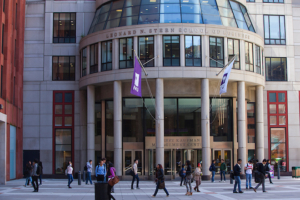
The Stern School of Business at New York University. NYU holds steady as the top feeder school to Wall Street. Stern School of Business courtesy photo.
PUTTING THE DATA TO WORK
With close to 60,000 submissions from its member community of financial services professionals to-date, WSO’s total universe of data is representative of thousands of companies based purely on self-reported user information on various metrics.
In the case of university stats to see which schools are sending the most grads to top banks, WSO’s thousands of submissions are whittled down to the subset of users found in bulge bracket and notable mid-market banks. Likewise, this subset is further broken down to just include the past two and a half years of submissions in order to offer an accurate picture of which schools are currently churning out the most Wall Street grads. With this sample pool in hand, WSO then combs through all of its submissions to identify the overall distribution of users from each school to each of the reported bulge bracket and mid-market firms.
If you’re wondering if big banks only recruit from Northeastern and Ivy League schools, the answer is no. Beyond the top five schools sending graduates to the big leagues on Wall Street are the University of Texas at Austin, the University of California-Berkeley, the University of Chicago, the University of Michigan, and the University of Virginia. Also to note, making its mark in the top 25 is one international school: London School of Economics.
WSO data also indicates that attending a highly ranked school or what’s considered a “target school” is not the only ticket to Wall Street. For instance, WSO’s 28th ranked University of Florida scores high recruiting and hiring points from Wells Fargo as well as Deutsche Bank. In fact, Florida has a higher representation at these two firms relative to its overall distribution percentage when compared to the other 440+ schools.

Patrick Curtis is the CEO of Wall Street Oasis. Photo courtesy of Wall Street Oasis and Patrick Curtis
Want more proof? Curtis says to consider his alma mater Williams College. “It’s ranked 46th on bulge brackets then 223rd on the list that looks at other banks,” he says. “It’s interesting that it shows up 46 for big banks because it shows there is a presence there. It lines up with what I saw when I attended the school. It’s a tiny student body, but people are indeed getting placed from Williams to Wall Street.”
Curtis is correct. According to the May 2018 report, at least six WSO users are Williams College grads who are at Goldman Sachs and there’s at least one at several of the other bulge brackets including Citigroup, Morgan Stanley, and JPMorgan.
“It’s a longer tail than people think,” Curtis tells Poets&Quants for Undergrads. “You can get into investment banking from any school. It gets harder as you get out of the top 20-30 schools, but these are all great schools and they all have a presence.”
TRENDS AT OTHER HIGH-END BANKS AND SCHOOLS TO WATCH
If a mid-market or boutique bank is more your speed or your preference, NYU continues to dominate in this bracket as well; along with Penn. However, as probably expected, there are significant changes seen in the top 25. First, the top five includes the entrance of University of Virginia and University of West Ontario into the fold. Whereas there’s a dramatic drop for Cornell and Columbia, a spike is seen from schools including Indiana University, Vanderbilt University, UCLA, Emory University, and University of Georgia. The large drops and spikes signal that there may be at least some correlation between where you attend school and where you go to work.
Still, a closer look at the data shows different firms are sweet on different schools. PJT Partners seems to have an affinity for UPenn and Harvard grads, also Dartmouth College alum and — a little further down — students from WHU Otto Beisheim School of Management located in Germany. Lincoln is a fan of Notre Dame and Washington and Lee University grads while Harris Williams seems to lean toward UVA.
Says Curtis, “It’s interesting to see where the tendencies are such as which of the better known firms like Evercore may be harder to get into compared to some of the lesser known — but still reputable firms — such as a Keybanc.”











Questions about this article? Email us or leave a comment below.